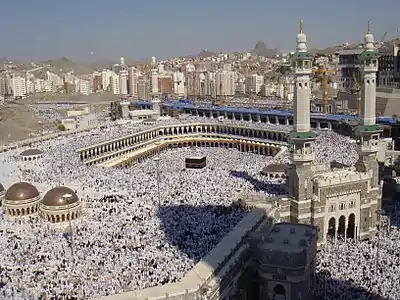Madrasa
Madrasa (/məˈdræsə/,[1] also US: /-rɑːs-/,[2][3] UK: /ˈmædrɑːsə/;[4] Arabic: مدرسة [maˈdrasa] (![]() listen), pl. مدارس, madāris) is the Arabic word for any type of educational institution, secular or religious (of any religion), whether for elementary instruction or higher learning. The word is variously transliterated madrasah, medresa, madrassa, madraza, medrese, etc. In countries outside the Arab world, the word usually refers to a specific type of religious school or college for the study of the religion of Islam, though this may not be the only subject studied.
listen), pl. مدارس, madāris) is the Arabic word for any type of educational institution, secular or religious (of any religion), whether for elementary instruction or higher learning. The word is variously transliterated madrasah, medresa, madrassa, madraza, medrese, etc. In countries outside the Arab world, the word usually refers to a specific type of religious school or college for the study of the religion of Islam, though this may not be the only subject studied.

| Part of a series on |
| Islam |
|---|
 |
|
In an architectural and historical context, the term generally refers to a particular kind of institution in the historic Muslim world which primarily taught Islamic law and jurisprudence (fiqh), as well as other subjects on occasion. The origin of this type of institution is widely credited to Nizam al-Mulk, a vizier under the Seljuks in the 11th century, who was responsible for building the first network of official madrasas in Iran, Mesopotamia, and Khorasan. From there, the construction of madrasas spread across much of the Muslim world over the next few centuries, often adopting similar models of architectural design.[5][6][7]
Definition
Etymology
The word madrasah derives from the triconsonantal Semitic root د-ر-س D-R-S 'to learn, study', using the wazn (morphological form or template) مفعل(ة); mafʻal(ah), meaning "a place where something is done". Thus, madrasah literally means "a place where learning and studying take place" or "place of study".[8][9][5] The word is also present as a loanword with the same general meaning in many Arabic-influenced languages, such as: Urdu, Punjabi, Bengali, Pashto, Baluchi, Persian, Turkish, Azeri, Kurdish, Indonesian, Somali and Bosnian.[10][11]
Arabic meaning
In the Arabic language, the word مدرسة madrasah simply means the same as school does in the English language, whether that is private, public or parochial school, as well as for any primary or secondary school whether Muslim, non-Muslim, or secular.[12][13] Unlike the use of the word school in British English, the word madrasah more closely resembles the term school in American English, in that it can refer to a university-level or post-graduate school as well as to a primary or secondary school. For example, in the Ottoman Empire during the Early Modern Period, madrasas had lower schools and specialised schools where the students became known as danişmends.[14] In medieval usage, however, the term madrasah was usually specific to institutions of higher learning, which generally taught Islamic law and occasionally other subjects, as opposed to elementary schools or children's schools, which were usually known as kuttāb or maktab.[6][7] The usual modern Arabic word for a university, however, is جامعة (jāmiʻah). The Hebrew cognate midrasha also connotes the meaning of a place of learning; the related term midrash literally refers to study or learning, but has acquired mystical and religious connotations.
Meaning and usage in English
In English, the term madrasah or "madrasa" usually refers more narrowly to Islamic institutions of learning. Historians and other scholars also employ the term to refer to historical madrasah institutions throughout the Muslim world, which is to say a college where Islamic law was taught along with other secondary subjects. These institutions were typically housed in specially designed buildings which were primarily devoted to this purpose. Such institutions are believed to have originated, or at least proliferated, in the region of Iran in the 11th century under vizier Nizam al-Mulk and subsequently spread to other regions of the Islamic world.[7][6][5]
History
Early history
_(qarawiyyin_crop).jpg.webp)
The first institute of madrasa education was at the estate of Zaid bin Arkam near a hill called Safa, where Muhammad was the teacher and the students were some of his followers. After Hijrah (migration) the madrasa of "Suffa" was established in Madina on the east side of the Al-Masjid an-Nabawi mosque. Ubada ibn as-Samit was appointed there by Muhammad as teacher and among the students. In the curriculum of the madrasa, there were teachings of The Qur'an, The Hadith, fara'iz, tajweed, genealogy, treatises of first aid, etc. There was also training in horse-riding, the art of war, handwriting and calligraphy, athletics and martial arts. The first part of madrasa-based education is estimated from the first day of "nabuwwat" to the first portion of the Umayyad Caliphate. At the beginning of the Caliphate period, the reliance on courts initially confined sponsorship and scholarly activities to major centres.
In the early history of the Islamic period, teaching was generally carried out in mosques rather than in separate specialized institutions. Although some major early mosques like the Great Mosque of Damascus or the Mosque of Amr ibn al-As in Cairo had separate rooms which were devoted to teaching, this distinction between "mosque" and "madrasa" was not very present.[7] Notably, the al-Qarawiyyin (Jāmiʻat al-Qarawīyīn), established in 859 in the city of Fes, present-day Morocco, is considered the oldest university in the world by some scholars,[15] though the application of the term "university" to institutions of the medieval Muslim world is disputed.[16][17] According to tradition, the al-Qarawiyyin mosque was founded by Fāṭimah al-Fihrī, the daughter of a wealthy merchant named Muḥammad al-Fihrī. This was later followed by the Fatimid establishment of al-Azhar Mosque in 969–970 in Cairo, initially as a center to promote Isma'ili teachings, which later became a Sunni institution under Ayyubid rule (today's Al-Azhar University).[18][19][20][21]
The development of the formal madrasah
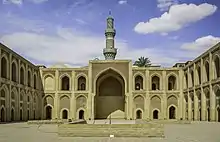
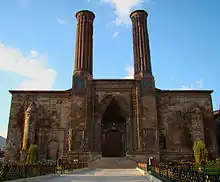
In the late 11th century, during the late ʻAbbāsid period, the Seljuk vizier Niẓām al-Mulk created one of the first major official academic institutions known in history as the Madrasah Niẓāmīyah, based on the informal majālis (sessions of the shaykhs). Niẓām al-Mulk, who would later be murdered by the Assassins (Ḥashshāshīn), created a system of state madrasas (in his time they were called the Niẓāmiyyahs, named after him) in various Seljuk and ʻAbbāsid cities at the end of the 11th century, ranging from Mesopotamia to Khorasan.[7][5] Although madrasa-type institutions appear to have existed in Iran before Nizam al-Mulk, this period is nonetheless considered by many as the starting point for the proliferation of the formal madrasah across the rest of the Muslim world, adapted for use by all four different Sunni Islamic legal schools and Sufi orders.[6][5][7] Part of the motivation for this widespread adoption of the madrasah by Sunni rulers and elites was a desire to counter the influence and spread of Shi'ism at the time, by using these institutions to spread Sunni teachings.[5][7][6]
Dimitri Gutas and the Stanford Encyclopedia of Philosophy consider the period between the 11th and 14th centuries to be the "Golden Age" of Arabic and Islamic philosophy, initiated by al-Ghazali's successful integration of logic into the madrasah curriculum and the subsequent rise of Avicennism.[22] In addition to religious subjects, they sometimes taught the "rational sciences," as varied as mathematics, astronomy, astrology, geography, alchemy, philosophy, magic, and occultism, depending on the curriculum of the specific institution in question.[23] The madrasas, however, were not centres of advanced scientific study; scientific advances in Islam were usually carried out by scholars working under the patronage of royal courts.[24] During the Islamic Golden Age, the territories under the Caliphate experienced a growth in literacy, having the highest literacy rate of the Middle Ages, comparable to classical Athens' literacy in antiquity but on a much larger scale.[25] The emergence of the maktab and madrasa institutions played a fundamental role in the relatively high literacy rates of the medieval Islamic world.[26]

Under the Anatolian Seljuk, Ayyubid, and Mamluk dynasties (11th-16th centuries) in the Middle East, many of the ruling elite founded madrasas through a religious endowment known as the waqf.[27][21][5][28] Not only was the madrasa a potent symbol of status for its patrons but it could also be an effective means of transmitting wealth and status to their descendants. Especially during the Mamluk period, when only former slaves (mamālīk) could assume power, the sons of the ruling Mamluk elites were unable to inherit. Guaranteed positions within the new madrasas (and other similar foundations) thus allowed them to maintain some status and means of living even after their fathers' deaths.[28] Madrasas built in this period include the monumental Mosque-Madrasah of Sultan Ḥasan in Cairo, as well as numerous other madrasas, often associated with the mausoleums of their founders.[28][29] By the late 13th century, the first madrasas were being built in Morocco under the Marinid dynasty, starting with the Saffarin Madrasa in Fes (founded in 1271) and culminating with much larger and more ornate constructions like the Bou Inania Madrasa (founded in 1350).[30][31]
During the Ottoman period the medrese (Turkish word for madrasah) was a common institution as well, often part of a larger külliye or a waqf-based religious foundation which included other elements like a mosque and a hammam (public bathhouse).[32] The following excerpt provides a brief synopsis of the historical origins and starting points for the teachings that took place in the Ottoman madrasas in the Early Modern Period:
Taşköprülüzâde's concept of knowledge and his division of the sciences provides a starting point for a study of learning and medrese education in the Ottoman Empire. Taşköprülüzâde recognises four stages of knowledge—spiritual, intellectual, oral and written. Thus all the sciences fall into one of these seven categories: calligraphic sciences, oral sciences, intellectual sciences, spiritual sciences, theoretical rational sciences, and practical rational sciences. The first Ottoman medrese was created in İznik in 1331, when a converted Church building was assigned as a medrese to a famous scholar, Dâvûd of Kayseri. Suleyman made an important change in the hierarchy of Ottoman medreses. He established four general medreses and two more for specialised studies, one devoted to the ḥadīth and the other to medicine. He gave the highest ranking to these and thus established the hierarchy of the medreses which was to continue until the end of the empire.[14]
Islamic education in the madrasa
The term "Islamic education" means education in the light of Islam itself, which is rooted in the teachings of the Qur'an - the holy book of the Muslims. Islamic education and Muslim education are not the same. Because Islamic education has epistemological integration which is founded on Tawhid - Oneness or monotheism.[33][34]
A typical Islamic school usually offers two courses of study: a ḥifẓ course teaching memorization of the Qur'an (the person who commits the entire Qur'an to memory is called a ḥāfiẓ); and an ʻālim course leading the candidate to become an accepted scholar in the community. A regular curriculum includes courses in Arabic, tafsir (Qur'anic interpretation), sharīʻah (Islamic law), hadiths (recorded sayings and deeds of Muhammad), mantiq (logic), and Muslim history. In the Ottoman Empire, during the Early Modern Period, the study of hadiths was introduced by Süleyman I.[14] Depending on the educational demands, some madrasas also offer additional advanced courses in Arabic literature, English and other foreign languages, as well as science and world history. Ottoman madrasas along with religious teachings also taught "styles of writing, grammar, syntax, poetry, composition, natural sciences, political sciences, and etiquette."[14]
People of all ages attend, and many often move on to becoming imams.[35] The certificate of an ʻālim, for example, requires approximately twelve years of study. A good number of the ḥuffāẓ (plural of ḥāfiẓ) are the product of the madrasas. The madrasas also resemble colleges, where people take evening classes and reside in dormitories. An important function of the madrasas is to admit orphans and poor children in order to provide them with education and training. Madrasas may enroll female students; however, they study separately from the men.
Education in historical madrasas
Elementary education
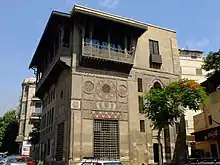
In the medieval Islamic world, an elementary school (for children or for those learning to read) was known as a 'kuttāb' or maktab. Their exact origin is uncertain, but they appear to have been already widespread in the early Abbasid period (8th-9th centuries) and may have played an early role in socializing new ethnic and demographic groups into the Islamic religion during the first few centuries after the Arab-Muslim conquests of the region.[36] Like madrasas (which referred to higher education), a maktab was often attached to an endowed mosque.[36] In the 11th century, the famous Persian Islamic philosopher and teacher Ibn Sīnā (known as Avicenna in the West), in one of his books, wrote a chapter about the maktab entitled "The Role of the Teacher in the Training and Upbringing of Children," as a guide to teachers working at maktab schools. He wrote that children can learn better if taught in classes instead of individual tuition from private tutors, and he gave a number of reasons for why this is the case, citing the value of competition and emulation among pupils, as well as the usefulness of group discussions and debates. Ibn Sīnā described the curriculum of a maktab school in some detail, describing the curricula for two stages of education in a maktab school.[37]
Primary education
Ibn Sīnā wrote that children should be sent to a maktab school from the age of 6 and be taught primary education until they reach the age of 14. During which time, he wrote, they should be taught the Qur'an, Islamic metaphysics, Arabic, literature, Islamic ethics, and manual skills (which could refer to a variety of practical skills).[37]
Secondary education
Ibn Sīnā refers to the secondary education stage of maktab schooling as a period of specialisation when pupils should begin to acquire manual skills, regardless of their social status. He writes that children after the age of 14 should be allowed to choose and specialise in subjects they have an interest in, whether it was reading, manual skills, literature, preaching, medicine, geometry, trade and commerce, craftsmanship, or any other subject or profession they would be interested in pursuing for a future career. He wrote that this was a transitional stage and that there needs to be flexibility regarding the age in which pupils graduate, as the student's emotional development and chosen subjects need to be taken into account.[38]
Higher education
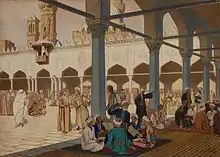
During its formative period, the term madrasah referred to a higher education institution, whose curriculum initially included only the "religious sciences", whilst philosophy and the secular sciences were often excluded.[39] The curriculum slowly began to diversify, with many later madrasas teaching both the religious and the "secular sciences",[40] such as logic, mathematics and philosophy.[41] Some madrasas further extended their curriculum to history, politics, ethics, music, metaphysics, medicine, astronomy and chemistry.[42][43] The curriculum of a madrasah was usually set by its founder, but most generally taught both the religious sciences and the physical sciences. Madrasas were established throughout the Islamic world, examples being the 9th century University of al-Qarawiyyin, the 10th century al-Azhar University (the most famous), the 11th century Niẓāmīyah, as well as 75 madrasas in Cairo, 51 in Damascus and up to 44 in Aleppo between 1155 and 1260. Many more were also established in the Andalusian cities of Córdoba, Seville, Toledo, Granada (Madrasah of Granada), Murcia, Almería, Valencia and Cádiz during the Caliphate of Córdoba.[44]
In the Ottoman Empire during the early modern period, "Madaris were divided into lower and specialised levels, which reveals that there was a sense of elevation in school. Students who studied in the specialised schools after completing courses in the lower levels became known as danişmends."[14]
While "madrasah" can now refer to any type of school, the term madrasah was originally used to refer more specifically to a medieval Islamic centre of learning, mainly teaching Islamic law and theology, usually affiliated with a mosque, and funded by an early charitable trust known as waqf.[45]
Law school
Madrasas were largely centred on the study of fiqh (Islamic jurisprudence). The ijāzat al-tadrīs wa-al-iftāʼ ("licence to teach and issue legal opinions") in the medieval Islamic legal education system had its origins in the 9th century after the formation of the madhāhib (schools of jurisprudence). George Makdisi considers the ijāzah to be the origin of the European doctorate.[46] However, in an earlier article, he considered the ijāzah to be of "fundamental difference" to the medieval doctorate, since the former was awarded by an individual teacher-scholar not obliged to follow any formal criteria, whereas the latter was conferred on the student by the collective authority of the faculty.[47] To obtain an ijāzah, a student "had to study in a guild school of law, usually four years for the basic undergraduate course" and ten or more years for a post-graduate course. The "doctorate was obtained after an oral examination to determine the originality of the candidate's theses", and to test the student's "ability to defend them against all objections, in disputations set up for the purpose." These were scholarly exercises practised throughout the student's "career as a graduate student of law." After students completed their post-graduate education, they were awarded ijazas giving them the status of faqīh 'scholar of jurisprudence', muftī 'scholar competent in issuing fatwās', and mudarris 'teacher'.[46]
.jpg.webp)
The Arabic term ijāzat al-tadrīs was awarded to Islamic scholars who were qualified to teach. According to Makdisi, the Latin title licentia docendi 'licence to teach' in the European university may have been a translation of the Arabic,[46] but the underlying concept was very different.[47] A significant difference between the ijāzat al-tadrīs and the licentia docendi was that the former was awarded by the individual scholar-teacher, while the latter was awarded by the chief official of the university, who represented the collective faculty, rather than the individual scholar-teacher.[48]
Much of the study in the madrasah college centred on examining whether certain opinions of law were orthodox. This scholarly process of "determining orthodoxy began with a question which the Muslim layman, called in that capacity mustaftī, presented to a jurisconsult, called mufti, soliciting from him a response, called fatwa, a legal opinion (the religious law of Islam covers civil as well as religious matters). The mufti (professor of legal opinions) took this question, studied it, researched it intensively in the sacred scriptures, in order to find a solution to it. This process of scholarly research was called ijtihād, literally, the exertion of one's efforts to the utmost limit."[46]
Medical school
Though Islamic medicine was most often taught at the bimaristan teaching hospitals, there were also several medical madrasas dedicated to the teaching of medicine. For example, of the 155 madrasa colleges in 15th century Damascus, three of them were medical schools.[49]
Toby Huff argues that no medical degrees were granted to students, as there was no faculty that could issue them, and that therefore, no system of examination and certification developed in the Islamic tradition like that of medieval Europe.[50] However, the historians Andrew C. Miller, Nigel J. Shanks and Dawshe Al-Kalai point out that, during this era, physician licensure became mandatory in the Abbasid Caliphate.[51][52] In 931 AD, Caliph Al-Muqtadir learned of the death of one of his subjects as a result of a physician's error.[52] He immediately ordered his muhtasib Sinan ibn Thabit to examine and prevent doctors from practicing until they passed an examination.[52][51] From this time on, licensing exams were required and only qualified physicians were allowed to practice medicine.[52][51]
In the Early Modern Period in the Ottoman Empire, "Suleyman I added new curriculums ['sic'] to the Ottoman medreses of which one was medicine, which alongside studying of the ḥadīth was given highest rank."[14]
Madrasa and university
- Note: The word jāmiʻah (Arabic: جامعة) simply means 'university'. For more information, see Islamic university (disambiguation).
Scholars like Arnold H. Green and Seyyed Hossein Nasr have argued that, starting in the 10th century, some medieval Islamic madrasas indeed became universities.[53][54] However, scholars like George Makdisi, Toby Huff and Norman Daniel[55][56] argue that the European medieval university has no parallel in the medieval Islamic world.[57][58] Darleen Pryds questions this view, pointing out that madrasas and European universities in the Mediterranean region shared similar foundations by princely patrons and were intended to provide loyal administrators to further the rulers' agenda.[59] A number of scholars regard the university as uniquely European in origin and characteristics.[60][61][62][63][64] According to Encyclopædia Britannica, however, the earliest universities were founded in Asia and Africa, predating the first European medieval universities.[65]
Al-Qarawīyīn University in Fez, present-day Morocco is recognised by many historians as the oldest degree-granting university in the world, having been founded in 859 as a mosque by Fatima al-Fihri.[66][67][68] While the madrasa college could also issue degrees at all levels, the jāmiʻahs (such as al-Qarawīyīn and al-Azhar University) differed in the sense that they were larger institutions, more universal in terms of their complete source of studies, had individual faculties for different subjects, and could house a number of mosques, madrasas, and other institutions within them.[45] Such an institution has thus been described as an "Islamic university".[69]

Al-Azhar University, founded in Cairo, Egypt in 975 by the Ismaʻīlī Shīʻī Fatimid dynasty as a jāmiʻah, had individual faculties[70] for a theological seminary, Islamic law and jurisprudence, Arabic grammar, Islamic astronomy, early Islamic philosophy and logic in Islamic philosophy.[71] The postgraduate doctorate in law was only obtained after "an oral examination to determine the originality of the candidate's theses", and to test the student's "ability to defend them against all objections, in disputations set up for the purpose."[46] ‘Abd al-Laṭīf al-Baghdādī also delivered lectures on Islamic medicine at al-Azhar, while Maimonides delivered lectures on medicine and astronomy there during the time of Saladin.[72] Another early jāmiʻah was the Niẓāmīyah of Baghdād (founded 1091), which has been called the "largest university of the Medieval world."[73] Mustansiriya University, established by the ʻAbbāsid caliph al-Mustanṣir in 1227,[74] in addition to teaching the religious subjects, offered courses dealing with philosophy, mathematics and the natural sciences.
However, the classification of madrasas as "universities" is disputed on the question of understanding of each institution on its own terms. In madrasas, the ijāzahs were only issued in one field, the Islamic religious law of sharīʻah, and in no other field of learning.[75] Other academic subjects, including the natural sciences, philosophy and literary studies, were only treated "ancillary" to the study of the Sharia.[76] For example, a natural science like astronomy was only studied (if at all) to supply religious needs, like the time for prayer.[77] This is why Ptolemaic astronomy was considered adequate, and is still taught in some modern day madrasas.[77] The Islamic law undergraduate degree from al-Azhar, the most prestigious madrasa, was traditionally granted without final examinations, but on the basis of the students' attentive attendance to courses.[78] In contrast to the medieval doctorate which was granted by the collective authority of the faculty, the Islamic degree was not granted by the teacher to the pupil based on any formal criteria, but remained a "personal matter, the sole prerogative of the person bestowing it; no one could force him to give one".[79]
Medievalist specialists who define the university as a legally autonomous corporation disagree with the term "university" for the Islamic madrasas and jāmi‘ahs because the medieval university (from Latin universitas) was structurally different, being a legally autonomous corporation rather than a waqf institution like the madrasa and jāmiʻah.[80] Despite the many similarities, medieval specialists have coined the term "Islamic college" for madrasa and jāmiʻah to differentiate them from the legally autonomous corporations that the medieval European universities were. In a sense, the madrasa resembles a university college in that it has most of the features of a university, but lacks the corporate element. Toby Huff summarises the difference as follows:
From a structural and legal point of view, the madrasa and the university were contrasting types. Whereas the madrasa was a pious endowment under the law of religious and charitable foundations (waqf), the universities of Europe were legally autonomous corporate entities that had many legal rights and privileges. These included the capacity to make their own internal rules and regulations, the right to buy and sell property, to have legal representation in various forums, to make contracts, to sue and be sued."[81]
As Muslim institutions of higher learning, the madrasa had the legal designation of waqf. In central and eastern Islamic lands, the view that the madrasa, as a charitable endowment, will remain under the control of the donor (and their descendant), resulted in a "spurt" of establishment of madrasas in the 11th and 12th centuries. However, in Western Islamic lands, where the Maliki views prohibited donors from controlling their endowment, madrasas were not as popular. Unlike the corporate designation of Western institutions of higher learning, the waqf designation seemed to have led to the exclusion of non-orthodox religious subjects such a philosophy and natural science from the curricula.[82] The madrasa of al-Qarawīyīn, one of the two surviving madrasas that predate the founding of the earliest medieval universities and are thus claimed to be the "first universities" by some authors, has acquired official university status as late as 1947.[83] The other, al-Azhar, did acquire this status in name and essence only in the course of numerous reforms during the 19th and 20th century, notably the one of 1961 which introduced non-religious subjects to its curriculum, such as economics, engineering, medicine, and agriculture.[84] Many medieval universities were run for centuries as Christian cathedral schools or monastic schools prior to their formal establishment as universitas scholarium; evidence of these immediate forerunners of the university dates back to the 6th century AD,[85] thus well preceding the earliest madrasas. George Makdisi, who has published most extensively on the topic[86] concludes in his comparison between the two institutions:
Thus the university, as a form of social organization, was peculiar to medieval Europe. Later, it was exported to all parts of the world, including the Muslim East; and it has remained with us down to the present day. But back in the middle ages, outside of Europe, there was nothing anything quite like it anywhere.[87]
Nevertheless, Makdisi has asserted that the European university borrowed many of its features from the Islamic madrasa, including the concepts of a degree and doctorate.[46] Makdisi and Hugh Goddard have also highlighted other terms and concepts now used in modern universities which most likely have Islamic origins, including "the fact that we still talk of professors holding the 'chairman' of their subject" being based on the "traditional Islamic pattern of teaching where the professor sits on a chair and the students sit around him", the term 'academic circles' being derived from the way in which Islamic students "sat in a circle around their professor", and terms such as "having 'fellows', 'reading' a subject, and obtaining 'degrees', can all be traced back" to the Islamic concepts of aṣḥāb ('companions, as of Muhammad'), qirāʼah ('reading aloud the Qur'an') and ijāzah ('licence [to teach]') respectively. Makdisi has listed eighteen such parallels in terminology which can be traced back to their roots in Islamic education. Some of the practices now common in modern universities which Makdisi and Goddard trace back to an Islamic root include "practices such as delivering inaugural lectures, wearing academic robes, obtaining doctorates by defending a thesis, and even the idea of academic freedom are also modelled on Islamic custom."[88] The Islamic scholarly system of fatwá and ijmāʻ, meaning opinion and consensus respectively, formed the basis of the "scholarly system the West has practised in university scholarship from the Middle Ages down to the present day."[89] According to Makdisi and Goddard, "the idea of academic freedom" in universities was also "modelled on Islamic custom" as practised in the medieval Madrasa system from the 9th century. Islamic influence was "certainly discernible in the foundation of the first deliberately planned university" in Europe, the University of Naples Federico II founded by Frederick II, Holy Roman Emperor in 1224.[88]
However, all of these facets of medieval university life are considered by other scholars to be independent medieval European developments with no necessary Islamic influence.[90] Norman Daniel criticizes Makdisi for overstating his case by simply resting on "the accumulation of close parallels" while failing to point to convincing channels of transmission between the Muslim and Christian world.[91] Daniel also points out that the Arab equivalent of the Latin disputation, the taliqa, was reserved for the ruler's court, not the madrasa, and that the actual differences between Islamic fiqh and medieval European civil law were profound.[91] The taliqa only reached Islamic Spain, the only likely point of transmission, after the establishment of the first medieval universities.[91] Moroever, there is no Latin translation of the taliqa and, most importantly, no evidence of Latin scholars ever showing awareness of Arab influence on the Latin method of disputation, something they would have certainly found noteworthy.[91] Rather, it was the medieval reception of the Greek Organon which set the scholastic sic et non in motion.[92] Daniel concludes that resemblances in method had more to with the two religions having "common problems: to reconcile the conflicting statements of their own authorities, and to safeguard the data of revelation from the impact of Greek philosophy"; thus Christian scholasticism and similar Arab concepts should be viewed in terms of a parallel occurrence, not of the transmission of ideas from one to the other,[92] a view shared by Hugh Kennedy.[93] Toby Huff, in a discussion of Makdisi's hypothesis, argues:
It remains the case that no equivalent of the bachelor's degree, the licentia docendi, or higher degrees ever emerged in the medieval or early modern Islamic madrasas.[94]
George Saliba criticized Huff's views regarding the legal autonomy of European universities and limited curriculum of Madrasahs, demonstrating that there were many Madrasahs dedicated to the teaching of non-religious subjects and arguing that Madrasahs generally had greater legal autonomy than medieval European universities. According to Saliba, Madrasahs "were fully protected from interference in their curriculum by the very endowments that established them in the first place." Examples include the Dakhwariyya madrasah in Damascus, which was dedicated to medicine, a subject also taught at Islamic hospitals; the Madrasah established by Kamal al-Din Ibn Man`a (d. 1242) in Mosul which taught astronomy, music, and the Old the New Testaments; Ulugh Beg’s Madrasah in Samarqand which taught astronomy; and Shi`i madrasahs in Iran which taught astronomy along with religious studies. According to Saliba:[95]
As I noted in my original article, students in the medieval Islamic world, who had the full freedom to chose their teacher and the subjects that they would study together, could not have been worse off than today’s students, who are required to pursue a specific curriculum that is usually designed to promote the ideas of their elders and preserve tradition, rather than introduce them to innovative ideas that challenge ‘received texts.’ Moreover, if Professor Huff had looked more carefully at the European institutions that produced science, he would have found that they were mainly academies and royal courts protected by individual potentates and not the universities that he wishes to promote. But neither universities nor courts were beyond the reach of the Inquisition, which is another point that he seems to neglect.
Female education
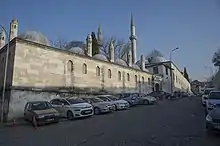
Prior to the 12th century, women accounted for less than one percent of the world’s Islamic scholars. However, al-Sakhawi and Mohammad Akram Nadwi have since found evidence of over 8,000 female scholars since the 15th century.[96] al-Sakhawi devotes an entire volume of his 12-volume biographical dictionary al-Ḍawʾ al-lāmiʻ to female scholars, giving information on 1,075 of them.[97] More recently, the scholar Mohammad Akram Nadwi, currently a researcher from the Oxford Centre for Islamic Studies, has written 40 volumes on the muḥaddithāt (the women scholars of hadith), and found at least 8,000 of them.[98]
From around 750, during the Abbasid Caliphate, women "became renowned for their brains as well as their beauty".[99] In particular, many well known women of the time were trained from childhood in music, dancing and poetry. Mahbuba was one of these. Another feminine figure to be remembered for her achievements was Tawaddud, "a slave girl who was said to have been bought at great cost by Hārūn al-Rashīd because she had passed her examinations by the most eminent scholars in astronomy, medicine, law, philosophy, music, history, Arabic grammar, literature, theology and chess".[100] Moreover, among the most prominent feminine figures was Shuhda who was known as "the Scholar" or "the Pride of Women" during the 12th century in Baghdad. Despite the recognition of women's aptitudes during the Abbasid dynasty, all these came to an end in Iraq with the sack of Baghdad in 1258.[101]
Women played an important role in the foundations of many Islamic educational institutions, such as Fatima al-Fihri's founding of the al-Qarawiyyin mosque in 859, which later developed into a madrasa. This continued through to the Ayyubid dynasty in the 12th and 13th centuries, when 160 mosques and madrasas were established in Damascus, 26 of which were funded by women through the Waqf (charitable trust) system. Half of all the royal patrons for these institutions were also women.[102]
According to the Sunni scholar Ibn ʻAsākir in the 12th century, there were opportunities for female education in the medieval Islamic world, writing that women could study, earn ijazahs (academic degrees), and qualify as scholars and teachers. This was especially the case for learned and scholarly families, who wanted to ensure the highest possible education for both their sons and daughters.[103] Ibn ʻAsakir had himself studied under 80 different female teachers in his time. Female education in the Islamic world was inspired by Muhammad's wives, such as Khadijah, a successful businesswoman, and 'A'isha, a strong leader and interpreter of the Prophet's actions. According to a hadith attributed both to Muhammad and 'A'isha, the women of Medina were praiseworthy because of their desire for religious knowledge:[104][105]
How splendid were the women of the ansar; shame did not prevent them from becoming learned in the faith.
While it was not common for women to enroll as students in formal classes, it was common for women to attend informal lectures and study sessions at mosques, madrasas and other public places. While there were no legal restrictions on female education, some men did not approve of this practice, such as Muhammad ibn al-Hajj (d. 1336) who was appalled at the behaviour of some women who informally audited lectures in his time:[106]
[Consider] what some women do when people gather with a shaykh to hear [the recitation of] books. At that point women come, too, to hear the readings; the men sit in one place, the women facing them. It even happens at such times that some of the women are carried away by the situation; one will stand up, and sit down, and shout in a loud voice. [Moreover,] her awra will appear; in her house, their exposure would be forbidden — how can it be allowed in a mosque, in the presence of men?
The term ʻawrah is often translated as 'that which is indecent', which usually meant the exposure of anything other than a woman's face and hands, although scholarly interpretations of the ʻawrah and ḥijāb have always tended to vary, with some more or less strict than others.[106]
Architecture
Architectural origins
Madrasas were generally centered around an interior courtyard and the classical madrasa form generally featured four iwans (vaulted chambers open on one side) arranged symmetrically around the courtyard. The origin of this architectural model may have been Buddhist monasteries in Transoxiana (Central Asia), of which some early surviving remains demonstrate this type of layout.[5][7] Another possible origin may have been domestic houses in the region of Khorasan.[5][7] Practically none of the first madrasas founded under Nizam al-Mulk (Seljuk vizier between 1064 and 1092) have survived, though partial remains of one madrasa in Khargerd, Iran, include an iwan and an inscription attributing it to Nizam al-Mulk. Nonetheless, it is clear that the Seljuks constructed many madrasas across their empire within a relatively short period of time, thus spreading both the idea of this institution and the architectural models on which later examples were based.[5][7]
Seljuk Anatolia
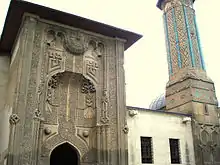
In contrast to early Iranian Seljuk madrasas, a large number of madrasas from the Anatolian Seljuk Empire (between 1077 and 1308) have survived, and are the closest examples we have of Iranian-influenced early madrasa architecture.[7] However, though each usually included a large central courtyard, their overall layouts were more variable and may have reflected more multi-purpose functions, often with an attached mausoleum, a minaret, and an ornate entrance portal. The courtyards were sometimes covered by a large dome (as with the Karatay Madrasa, founded in 1279, and other madrasas in Konya), reflecting an ongoing transition to domed Islamic buildings in Anatolia and later Ottoman architecture.[5]
Syria and Egypt
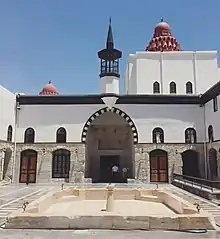
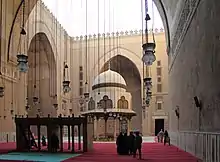
In Syria and the surrounding region, the earliest madrasas were often relatively small buildings, the earliest example of which is one in Bosra founded in 1136–37.[5][7] Madrasa architecture in this region appears to have evolved out of Seljuk prototypes.[7] Another early important example is the Madrasa of Nur al-Din from 1167.[7] Under the Ayyubid dynasty madrasas began to take on added importance, with the first madrasa in Egypt (no longer extant) being built by Salah ad-Din (Saladin) in 1180 next to the Mausoleum of Imam al-Shafi'i in Cairo's Qarafa Cemetery. As with the earlier Seljuk madrasas, is likely that these foundations were motivated by a desire to counteract the influence of Isma'ili proselytism and propaganda efforts during the Fatimid Caliphate.[5][107][29][7] Among the surviving Ayyubid madrasas in Egypt are the remains of the Madrasa of al-Kamil (founded by Sultan al-Kamil Ayyub in 1229) and the more important Madrasa al-Salihiyya founded by Sultan al-Salih Ayyub founded in 1242, to which was later attached al-Salih's mausoleum.[29] In Syria, an exceptional example of a monumental madrasa from this period is the al-Firdaws Madrasa in Aleppo.[5][7] Many more examples from this period, however, have not survived.[7]
After the faltering of the Ayyubid dynasty and the transition to the Mamluk Sultanate around 1250, the Mamluks became eager patrons of architecture. Many of their projects involved the construction of madrasas as part of larger multi-functional religious complexes, usually attached to their personal mausoleums, which provided services to the general population while also promoting their own prestige and pious reputations.[28] In Egyptian Mamluk architecture, which largely used stone, the madrasa layout generally had two prominent iwans which were aligned to the qibla and faced each other across a central courtyard, while two "lateral" iwans faced each across each on the other two sides of the courtyard. Prominent examples of these include the madrasa of the Sultan Qalawun complex (built in 1284–1285) and the neighbouring complex of his son al-Nasir Muhammad (finished in 1304).[28][29] One exceptional madrasa, which also served as a mosque and was easily one of the most massive structures of its time, was the monumental Madrasa-Mosque of Sultan Hasan (built from 1356 to 1363), with a large central courtyard surrounded by four enormous iwans. While the unique Madrasa of Sultan Hasan provided instruction in all four Sunni legal schools of thought, most madrasas and mosques in Egypt followed the Shafi'i school. Moreover, due to the already dense urban fabric of Cairo, Mamluk architectural complexes adopted increasingly irregular and creatively designed floor plans to compensate for limited space while simultaneously attempting to maximize their prominence and visibility from the street.[5][29][28][108][109]
While Mamluk architecture outside Cairo was generally of lesser quality and craftsmanship, there were nonetheless many examples. The Madrasa al-Zahiriyya in Damascus, which contains the mausoleum of Sultan Baybars I, is still essentially Ayyubid in style.[7] The city of Tripoli in Lebanon also holds a concentration of Mamluk-era architecture, including madrasas. However, the most significant Mamluk archtiectural patronage outside of Cairo is likely in Jerusalem, as with the example of the major al-Ashrafiyya Madrasa on the Temple Mount (Haram al-Sharif), which was rebuilt in its current form by Sultan Qaytbay in the late 15th century.[7]
Maghreb (North Africa)
.jpeg.webp)
In northwestern Africa (the Maghrib or Maghreb), including Morocco, Algeria, and Tunisia, madrasas began to be constructed in the 13th century under the Marinid and Hafsid dynasties.[30][7] In Tunisia (or Ifriqiya), the earliest Hafsid madrasa was the Madrasa al-Shamma'iyya founded in 1238[110][5]:209 (or in 1249 according to some sources[111][30]:296). In Morocco, the first madrasa was the Madrasa as-Saffarin built in Fes in 1271, followed by many others constructed around the country. The main architectural highlights among these are the Madrasa as-Sahrij (built in 1321–1328), the Madrasa al-Attarin (built in 1323–1325), and the Madrasa of Salé (completed in 1341), all of which are lavishly decorated with sculpted wood, carved stucco, and zellij mosaic tilework.[112][31][113] The Bou Inania Madrasa in Fes, built in 1350–1355, distinguished itself from other madrasas by its size and by being the only madrasa which also officially functioned as a public Friday mosque.[114][30] The Marinids also built madrasas in Algeria, particularly in Tlemcen.[30]
In Morocco, madrasas were generally built in brick and wood and were still centered around a main internal courtyard with a central fountain or water basin, around which student dorms were distributed across one or two floors. A prayer hall or mosque chamber usually stood opposite the entrance on one side of the courtyard. The Bou Inania Madrasa in Fes also contained two side-chambers opening off the lateral sides of its courtyard, which may reflect an influence of the older four-iwan layout.[30]:293 However, most other Moroccan madrasas did not have this feature and the courtyards were instead flanked by ornate galleries. By contrast with Mamluk structures to the east, Moroccan and Maghrebi madrasas were not prominently distinguishable from the outside except for an ornate entrance portal decorated with carved wood and stucco. This model continued to be found in later madrasas like the Ben Youssef Madrasa of the 16th century in Marrakesh.[30][113][115][112]
Iran, Iraq, and Central Asia
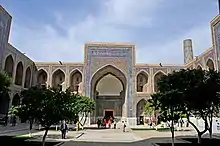
Very few if any formal madrasas from before the Mongol invasions have survived in Iran.[7] One exception is the Mustansiriyya Madrasa in Baghdad, which dates from 1227 and is also the earliest "universal" madrasa, which is to say the first madrasa that taught all four Sunni maddhabs (legal schools of thought).[74][7] Later, the Mongol Ilkhanid dynasty and the many dynasties that followed them (e.g. the Timurids and Safavids) nonetheless built numerous monumental madrasas, many of which are excellent examples of Iranian Islamic architecture.[5] In some cases, these madrasas were directly attached and integrated into larger mosques, as with those attached to the Shah Mosque in Isfahan (17th century). In other cases they were built as more or less separate entities, such as with the Chahar Bagh Madrasa[116] (also in Isfahan, 17th-18th centuries), or the 15th-century Timurid Ulugh Beg Madrasa and two other monumental 17th-century madrasas at the Registan complex in Samarkand.[5]
The form of the madrasa does not appear to have changed significantly over time in this region. The Timurid period (late 14th and 15th century), however, was a "golden age" of Iranian madrasas, during which the four-iwan model was made much larger and more monumental, on a par with major mosques, thanks to intense patronage from Timur and his successors.[7] Madrasas in the Iranian architectural tradition continued to be centered around a large square or rectangular courtyard with a central water basin and surrounded by a one or two-story arcade. Either two or four large iwans stood at the ends of the central axes of the courtyard.[5]
Ottoman Empire

Ottoman architecture evolved out of its Anatolian Seljuk predecessors into a particular style. In the classical Ottoman period (15th-16th centuries), the typical form of the madrasa had become a large courtyard surrounded by an arched gallery covered by a series of domes, similar to the sahn (courtyard) of imperial mosques. Madrasas were generally limited to a main ground floor, and were often built as auxiliary buildings to a central mosque which anchored a külliye or charitable complex.[117][7] This marked a certain departure from other madrasa styles as it emphasized the feeling of space for its own sake instead of focusing on the practical function of housing as many students as possible within a small area.[7] This is evident in the külliye complex of Mehmet II Fatih, which included 16 madrasa buildings arranged symmetrically around the Fatih Mosque. The Süleymaniye complex, often considered the apogee of Ottoman architecture, included four madrasas as part of a vast and carefully designed architectural ensemble at the top of one of Istanbul's highest hills.[7][117][118]
Madrasas by region
Ottoman Empire
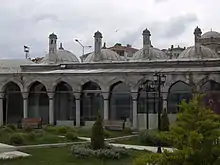
"The first Ottoman Medrese was created in İznik in 1331 and most Ottoman medreses followed the traditions of Sunni Islam."[14] "When an Ottoman sultan established a new medrese, he would invite scholars from the Islamic world—for example, Murad II brought scholars from Persia, such as ʻAlāʼ al-Dīn and Fakhr al-Dīn who helped enhance the reputation of the Ottoman medrese".[14] This reveals that the Islamic world was interconnected in the early modern period as they travelled around to other Islamic states exchanging knowledge. This sense that the Ottoman Empire was becoming modernised through globalization is also recognised by Hamadeh who says: "Change in the eighteenth century as the beginning of a long and unilinear march toward westernisation reflects the two centuries of reformation in sovereign identity."[119] İnalcık also mentions that while scholars from for example Persia travelled to the Ottomans in order to share their knowledge, Ottomans travelled as well to receive education from scholars of these Islamic lands, such as Egypt, Persia and Turkestan.[14] Hence, this reveals that similar to today's modern world, individuals from the early modern society travelled abroad to receive education and share knowledge and that the world was more interconnected than it seems. Also, it reveals how the system of "schooling" was also similar to today's modern world where students travel abroad to different countries for studies. Examples of Ottoman madrasas are the ones built by Mehmed the Conqueror. He built eight madrasas that were built "on either side of the mosque where there were eight higher madrasas for specialised studies and eight lower medreses, which prepared students for these."[14] The fact that they were built around, or near mosques reveals the religious impulses behind madrasa building and it reveals the interconnectedness between institutions of learning and religion. The students who completed their education in the lower medreses became known as danismends.[14] This reveals that similar to the education system today, the Ottomans' educational system involved different kinds of schools attached to different kinds of levels. For example, there were lower madrasas and specialised ones, and for one to get into the specialised area meant that he had to complete the classes in the lower one in order to adequately prepare himself for higher learning.[14]
This is the rank of madrasas in the Ottoman Empire from the highest ranking to the lowest: (From İnalcık, 167).[14]
- Semniye
- Darulhadis
- Madrasas built by earlier sultans in Bursa.
- Madrasas endowed by great men of state.
Although Ottoman madrasas had a number of different branches of study, such as calligraphic sciences, oral sciences, and intellectual sciences, they primarily served the function of an Islamic centre for spiritual learning. "The goal of all knowledge and in particular, of the spiritual sciences is knowledge of God."[14] Religion, for the most part, determines the significance and importance of each science. As İnalcık mentions: "Those which aid religion are good and sciences like astrology are bad."[14] However, even though mathematics, or studies in logic were part of the madrasa's curriculum, they were all primarily concerned with religion. Even mathematics had a religious impulse behind its teachings. "The Ulema of the Ottoman medreses held the view that hostility to logic and mathematics was futile since these accustomed the mind to correct thinking and thus helped to reveal divine truths"[14] – key word being "divine". İnalcık also mentions that even philosophy was only allowed to be studied so that it helped to confirm the doctrines of Islam."[14] Hence, madrasas – schools were basically religious centres for religious teachings and learning in the Ottoman world. Although scholars such as Goffman have argued that the Ottomans were highly tolerant and lived in a pluralistic society, it seems that schools that were the main centres for learning were in fact heavily religious and were not religiously pluralistic, but rather Islamic in nature. Similarly, in Europe "Jewish children learned the Hebrew letters and texts of basic prayers at home, and then attended a school organised by the synagogue to study the Torah."[120] Wiesner-Hanks also says that Protestants also wanted to teach "proper religious values."[120] This shows that in the early modern period, Ottomans and Europeans were similar in their ideas about how schools should be managed and what they should be primarily focused on. Thus, Ottoman madrasas were very similar to present day schools in the sense that they offered a wide range of studies; however, these studies, in their ultimate objective, aimed to further solidify and consolidate Islamic practices and theories.
Curricula
As is previously mentioned, religion dominated much of the knowledge and teachings that were endowed upon students. "Religious learning as the only true science, whose sole aim was the understanding of God's word."[14] Thus, it is important to keep this impulse in mind when going over the curriculum that was taught.
The following is taken from İnalcık.[14]
- A) Calligraphic sciences—such as styles of writing.
- B) Oral sciences—such as Arabic language, grammar and syntax.
- C) Intellectual sciences—logic in Islamic philosophy.
- D) Spiritual sciences—theoretical, such as Islamic theology and mathematics; and practical, such as Islamic ethics and politics.
Social life and the medrese
As with any other country during the Early Modern Period, such as Italy and Spain in Europe, the Ottoman social life was interconnected with the medrese. Medreses were built in as part of a Mosque complex where many programmes, such as aid to the poor through soup kitchens, were held under the infrastructure of a mosque, which reveals the interconnectedness of religion and social life during this period. "The mosques to which medreses were attached, dominated the social life in Ottoman cities."[121] Social life was not dominated by religion only in the Muslim world of the Ottoman Empire; it was also quite similar to the social life of Europe during this period. As Goffman says: "Just as mosques dominated social life for the Ottomans, churches and synagogues dominated life for the Christians and Jews as well."[121] Hence, social life and the medrese were closely linked, since medreses taught many curricula, such as religion, which highly governed social life in terms of establishing orthodoxy. "They tried moving their developing state toward Islamic orthodoxy."[121] Overall, the fact that mosques contained medreses comes to show the relevance of education to religion in the sense that education took place within the framework of religion and religion established social life by trying to create a common religious orthodoxy. Hence, medreses were simply part of the social life of society as students came to learn the fundamentals of their societal values and beliefs.
Maghreb
.jpg.webp)
In northwestern Africa (the Maghrib or Maghreb), including Morocco, Algeria, and Tunisia, the appearance of madrasas was delayed until after the fall of the Almohad dynasty, who espoused a reformist doctrine generally considered unorthodox by other Sunnis. As such, it only came to flourish in the region in the 13th century, under the Marinid and Hafsid dynasties which succeeded them.[30][7] In Tunisia (or Ifriqiya), the earliest Hafsid madrasa was the Madrasat al-Ma'raḍ, founded in Tunis in 1252 and followed by many others.[7] In Morocco, the first madrasa was the Madrasa as-Saffarin built in Fes in 1271, followed by many others constructed around the country.[112][31] The Marinids also built madrasas in Algeria, particularly in Tlemcen.[30]
As elsewhere, rulers in the Maghreb built madrasas to bolster their political legitimacy and that of their dynasty. The Marinids used their patronage of madrasas to cultivate the loyalty of Morocco's influential but independent religious elites and also to portray themselves to the general population as protectors and promoters of orthodox Sunni Islam.[30][31] Madrasas also served to train the scholars and educated elites who generally operated the state bureaucracy.[31] A number of madrasas also played a supporting role to major learning institutions like the older Qarawiyyin Mosque-University and the al-Andalusiyyin Mosque (both located in Fes) because they provided accommodations for students coming from other cities.[122]:137[123]:110 Many of these students were poor, seeking sufficient education to gain a higher position in their home towns, and the madrasas provided them with basic necessities such as lodging and bread.[114]:463 However, the madrasas were also teaching institutions in their own right and offered their own courses, but usually with much narrower and more limited curriculums than the Qarawiyyin.[123]:141[124] The Bou Inania Madrasa in Fes, distinguished itself from other madrasas by its size and by being the only madrasa which also officially functioned as a public Friday mosque.[114][30]
While some historical madrasas in Morocco remained in use well into the 20th century, most are no longer used for their original purpose following the reorganization of the Moroccan education system under French colonial rule and in the period following independence in 1956.[122][125][113] Likewise, while some madrasas are still used for learning in Tunisia, many have since been converted to other uses in modern times.[110]
South Asia
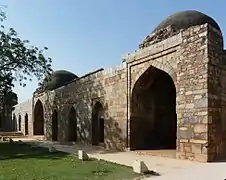
Bangladesh
There are three different madrasa education systems in Bangladesh: the original darse nizami system, the redesigned nizami system, and the higher syllabus alia nisab. The first two categories are commonly called Qawmi or non-government madrasas.[126] Amongst them the most notable are Al-Jamiatul Ahlia Darul Ulum Moinul Islam in Hathazari, Al-Jamiah Al-Islamiah Patiya, in Patiya, and Jamia Tawakkulia Renga Madrasah in Sylhet.
In 2006 there were 15,000 registered Qawmi madrasas with the Befaqul Mudarressin of Bangladesh Qawmi Madrasah Education Board,[127] though the figure could be well over double that number if unregistered madrasas were counted.[128]
India
.jpg.webp)

In 2008, India's madrassas were estimated to number between 8000 and 30,000, the state of Uttar Pradesh hosting most of them, estimated by the Indian government to have 10,000 of those back then.[129]
The majority of these schools follow the Hanafi school of thought. The religious establishment forms part of the mainly two large divisions within the country, namely the Deobandis, who dominate in numbers (of whom the Darul Uloom Deoband constitutes one of the biggest madrasas) and the Barelvis, who also make up a sizeable portion (Sufi-oriented). Some notable establishments include: Aljamea-tus-Saifiyah (Isma'ilism), Al Jamiatul Ashrafia, Mubarakpur, Manzar Islam Bareilly, Jamia Nizamdina New Delhi, Jamia Nayeemia Muradabad which is one of the largest learning centres for the Barelvis. The HR ministry of the government of India has recently declared that a Central Madrasa Board would be set up. This will enhance the education system of madrasas in India. Though the madrasas impart Quranic education mainly, efforts are on to include Mathematics, Computers and science in the curriculum.
In July 2015, the state government of Maharashtra created a stir when it de-recognised madrasa education, receiving criticism from several political parties with the NCP accusing the ruling BJP of creating Hindu-Muslim friction in the state, and Kamal Farooqui of the All India Muslim Personal Law Board saying it was "ill-designed"[130] [131]
Expansion
After the establishment of the British Raj and the emergence of Darul Ulum Manazar-e Islam Bareilly Sharif, Indian Muslim Scholars left India to establish madrasas in other regions of the world. Some of the most notable of these madrasas are Darul Ulum Holocombe, which produced scholars such as Shaikh Ibrahim Memon Madani, or Darul Uloom Al-Madania. These offshoot schools symbolise an emotional drive based upon both religion and patriotism that is not evident elsewhere.
In Kerala
Most of the Muslims of Kerala follow the traditional Shāfiʿī school of religious law (known in Kerala as the traditionalist 'Sunnis') while a large minority follow modern movements that developed within Sunni Islam.[132][133] The latter section consists of majority Salafists (the Mudjahids) and the minority Islamists (political Islam).[132][133]
Pakistan

The madrasas rose as colleges of learning in the Islamic world in the 11th century, though there were institutions of learning earlier. They catered not only to the religious establishment, though that was the dominant influence over them, but also the secular one. To the latter they supplied physicians, administrative officials, judges and teachers. Today many registered madrasas are working effectively and coping up with modern education system such as Jamia-tul-Madina which is a chain of Islamic schools in Pakistan and in European and other countries established by Dawat-e-Islami. The Jamia-tul-Madina are also known as Faizan-e-Madina. Dawat-e-Islami has grown its network of madrasas from Pakistan to Europe.
Southeast Asia
In Southeast Asia, Muslim students have a choice of attending a secular government or an Islamic school. Madrasas or Islamic schools are known as Sekolah Agama (Malay: religious school) in Malaysia and Indonesia, โรงเรียนศาสนาอิสลาม (Thai: school of Islam) in Thailand and madaris in the Philippines. In countries where Islam is not the majority or state religion, Islamic schools are found in regions such as southern Thailand (near the Thai-Malaysian border) and the southern Philippines in Mindanao, where a significant Muslim population can be found.
Indonesia
Singapore
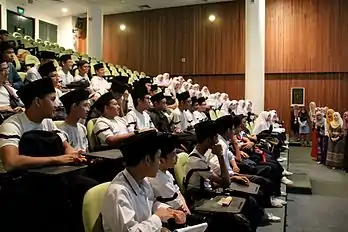
In Singapore, madrasahs are private schools which are overseen by Majlis Ugama Islam Singapura (MUIS, Islamic Religious Council of Singapore). There are six Madrasahs in Singapore, catering to students from Primary 1 to Secondary 4 (and junior college equivalent, or "Pre-U", at several schools).[135] Four Madrasahs are coeducational and two are for girls.[136] Students take a range of Islamic Studies subjects in addition to mainstream MOE curriculum subjects and sit for the PSLE and GCE 'O' Levels like their peers. In 2009, MUIS introduced the "Joint Madrasah System" (JMS), a joint collaboration of Madrasah Al-Irsyad Al-Islamiah primary school and secondary schools Madrasah Aljunied Al-Islamiah (offering the ukhrawi, or religious stream) and Madrasah Al-Arabiah Al-Islamiah (offering the academic stream).[137] The JMS aims to introduce the International Baccalaureate (IB) programme into the Madrasah Al-Arabiah Al-Islamiah by 2019.[138] Students attending a madrasah are required to wear the traditional Malay attire, including the songkok for boys and tudong for girls, in contrast to mainstream government schools which ban religious headgear as Singapore is officially a secular state. Students who wish to attend a mainstream school may opt to take classes on weekends at the madrasah instead of enrolling full-time.
Philippines
In 2004, madrasas were mainstreamed in 16 Regions nationwide, primarily in Muslim-majority areas in Mindanao under the auspices of the Department of Education (DepEd). The DepEd adopted Department Order No. 51, which instituted Arabic-language and Islamic Values instruction for Muslim children in state schools, and authorised implementation of the Standard Madrasa Curriculum (SMC) in private-run madrasas. While there are state-recognised Islamic schools, such as Ibn Siena Integrated School in the Islamic City of Marawi, Sarang Bangun LC in Zamboanga and SMIE in Jolo, their Islamic studies programmes initially varied in application and content.
Since 2005, the AusAID-funded DepEd project Basic Education Assistance for Mindanao (BEAM) has assisted a group of private madrasas seeking a Permit To Operate from the government and implement the SMC. These private madrasas are scattered throughout Regions XI, XII and the Autonomous Region in Muslim Mindanao.
Western countries

South Africa
In South Africa, the madrasas also play a social and cultural role in giving after-school religious instruction to children of Muslims who attend government or private non-religious schools. However, increasing numbers of more affluent Muslims' children attend fully-fledged private Islamic schools, which combine secular and religious education. Among Muslims of Indian origin, madrasas also used to provide instruction in Urdu, although this is far less common today than it used to be.
Canada
The first Madressa established in North America, Al-Rashid Islamic Institute, was established in Cornwall, Ontario in 1983 and has graduates who are Hafiz (Quran) and Ulama. The seminary was established by Mazhar Alam under the direction of his teacher the leading Indian Tablighi scholar Muhammad Zakariya Kandhlawi and focuses on the Hanafi school of thought. Due to its proximity to the US border city of Messina the school has historically had a high ratio of US students. Their most prominent graduate Shaykh Muhammad Alshareef completed his Hifz in the early 1990s then went on to form the AlMaghrib Institute.
United States
On May 26, 2012, Congressman André Carson of Indiana called for additional madrasas in the United States.[139] There is a madrassa in Queens, NY called Shia Ithna-Asheri Jamaat of New York.[140] Presently, the Darul Uloom in New York City, an affiliate of Darul Uloom Haqqania in Pakistan, also serves as a madrassa.
Common misconceptions
In the Arabic language, the word madrasa (مدرسه) means any educational institution, of any description, (as does the term school in American English)[141] and does not imply a political or religious affiliation, not even one as broad as Islam in the general sense. Madrasas often have varied curricula. Some madrasas in India, for example, have a secularised identity.[142] Although early madrasas were founded primarily to gain "knowledge of God" they also taught subjects such as mathematics and poetry. For example, in the Ottoman Empire, "Madrasahs had seven categories of sciences that were taught, such as: styles of writing, oral sciences like the Arabic language, grammar, rhetoric, and history and intellectual sciences, such as logic."[14] This is similar to the Western world, in which universities began as institutions of the Catholic church.
The Yale Center for the Study of Globalization examined bias in United States newspaper coverage of Pakistan since the September 11, 2001 attacks, and found the term has come to contain a loaded political meaning:[143]
When articles mentioned "madrassas," readers were led to infer that all schools so-named are anti-American, anti-Western, pro-terrorist centres having less to do with teaching basic literacy and more to do with political indoctrination.
Various American public figures have, in recent times, used the word in a negative context, including Newt Gingrich,[143] Donald Rumsfeld,[144] and Colin Powell.[145] The New York Times published in January 2007 a correction for misusing the word "madrassa" in a way that assumed it meant a radical Islamic school. The correction stated:
An article [...] about a pointed exchange [...] over a Web site report that said Senator Barack Obama had attended an Islamic school or madrassa in Indonesia as a child referred imprecisely to madrassas. While some [madrassas] teach a radical version of Islam, most historically have not.[146]
See also
|
References
Citations
- "madrasa" (US) and "madrasa". Oxford Dictionaries UK Dictionary. Oxford University Press. Retrieved 6 June 2019.
- "madrasa". The American Heritage Dictionary of the English Language (5th ed.). Boston: Houghton Mifflin Harcourt. Retrieved 6 June 2019.
- "madrassa". Merriam-Webster Dictionary. Retrieved 6 June 2019.
- "Madrasah". Collins English Dictionary. HarperCollins. Retrieved 6 June 2019.
- Bloom, Jonathan M.; Blair, Sheila S., eds. (2009). "Madrasa". The Grove Encyclopedia of Islamic Art and Architecture. Oxford University Press.
- Abaza, Mona; Kéchichian, Joseph A. (2009). "Madrasah". The Oxford Encyclopedia of the Islamic World. Oxford University Press.
- Pedersen, J.; Makdisi, G.; Rahman, Munibur; Hillenbrand, R. (2012). "Madrasa". Encyclopaedia of Islam, Second Edition. Brill.
- "madrasah | Origin and meaning of madrasah by Online Etymology Dictionary". www.etymonline.com. Retrieved 2020-08-13.
- "TenguGo". www.tengugo.com. Retrieved 2020-08-13.
- "Madarasaa". WordAnywhere. Archived from the original on 2007-09-27. Retrieved 2007-06-23.
- Hassim, E. (2020). "Madrassa". In List, Regina A.; Anheier, Helmut K.; Toepler, Stefan (eds.). International Encyclopedia of Civil Society. Springer.
- "Alternate Spellings of Madrassa". ThoughtCo. Retrieved 2017-05-30.
- Madrasah ʻāmmah (Arabic: مدرسة عامة) translates as 'public school', madrasah khāṣṣah (Arabic: مدرسة خاصة) translates as 'private school', madrasah dīnīyah (Arabic: مدرسة دينية) translates as 'religious school', madrasah Islāmīyah (Arabic: مدرسة إسلامية) translates as 'Islamic school', and madrasah jāmiʻah (Arabic: مدرسة جامعة) translates as 'university'.
- İnalcık, Halil. 1973. "Learning, the Medrese, and the Ulema." In The Ottoman Empire: The Classical Age 1300–1600. New York: Praeger, pp. 165–178.
- while other scholars have argued that this distinction belongs to the University of al-Qarawiyyin, also founded in 859.
- Esposito, John (2003). The Oxford Dictionary of Islam. Oxford University Press. p. 328. ISBN 0-19-512559-2.
- Kettani, M. Ali. Engineering Education in the Arab World. Middle East Journal, 1974, 28(4):441.
- Makdisi, George: "Madrasa and University in the Middle Ages", Studia Islamica, No. 32 (1970), pp. 255–264
- Verger, Jacques: "Patterns", in: Ridder-Symoens, Hilde de (ed.): A History of the University in Europe. Vol. I: Universities in the Middle Ages, Cambridge University Press, 2003, ISBN 978-0-521-54113-8, pp. 35–76 (35):
No one today would dispute the fact that universities, in the sense in which the term is now generally understood, were a creation of the Middle Ages, appearing for the first time between the twelfth and thirteenth centuries. It is no doubt true that other civilizations, prior to, or wholly alien to, the medieval West, such as the Roman Empire, Byzantium, Islam, or China, were familiar with forms of higher education which a number of historians, for the sake of convenience, have sometimes described as universities.Yet a closer look makes it plain that the institutional reality was altogether different and, no matter what has been said on the subject, there is no real link such as would justify us in associating them with medieval universities in the West. Until there is definite proof to the contrary, these latter must be regarded as the sole source of the model which gradually spread through the whole of Europe and then to the whole world. We are therefore concerned with what is indisputably an original institution, which can only be defined in terms of a historical analysis of its emergence and its mode of operation in concrete circumstances.
- Creswell, K.A.C. (1952). The Muslim Architecture of Egypt I, Ikhshids and Fatimids, A.D. 939–1171. Clarendon Press. p. 36.
- Brett, Michael (2017). The Fatimid Empire. Edinburgh University Press. p. 104.
- Behrens-Abouseif, Doris (1989). Islamic Architecture in Cairo: an Introduction. E.J. Brill. pp. 58–62.
- Jonathan Berkey, The Transmission of Knowledge in Medieval Cairo (Princeton: Princeton University Press, 1992), passim
- Tony Street (July 23, 2008). "Arabic and Islamic Philosophy of Language and Logic". Stanford Encyclopedia of Philosophy. Retrieved 2008-12-05.
- Sonja Brentjes (June 2003), "Between doubts and certainties: on the place of history of science in Islamic societies within the field of history of science", NTM Zeitschrift für Geschichte der Wissenschaften, Technik und Medizin, Springer, 11 (2): 65–79 [69], doi:10.1007/BF02908588, ISSN 1420-9144, PMID 12852421, S2CID 6271842
- Sabra, A. I. (2000) [1996], "Situating Arabic Science: Locality versus Essence", in Shank, Michael H. (ed.), The Scientific Enterprise in Antiquity and the Middle Ages, Chicago: University of Chicago Press, pp. 215–31, ISBN 0-226-74951-7, pages 225-7
- Andrew J. Coulson, Delivering Education (PDF), Hoover Institution, p. 117, retrieved 2008-11-22
- Edmund Burke (June 2009), "Islam at the Center: Technological Complexes and the Roots of Modernity", Journal of World History, University of Hawaii Press, 20 (2): 165–186 [178–82], doi:10.1353/jwh.0.0045, S2CID 143484233
- Ira Lapidus, Muslim Cities in the Later Middle Ages (Cambridge: Cambridge University Press, 1984), passim
- Behrens-Abouseif, Doris. 2007. Cairo of the Mamluks: A History of Architecture and its Culture. Cairo: The American University in Cairo Press.
- Williams, Caroline (2018). Islamic Monuments in Cairo: The Practical Guide (7th ed.). Cairo: The American University in Cairo Press.
- Marçais, Georges (1954). L'architecture musulmane d'Occident. Paris: Arts et métiers graphiques.
- Lintz, Yannick; Déléry, Claire; Tuil Leonetti, Bulle (2014). Maroc médiéval: Un empire de l'Afrique à l'Espagne. Paris: Louvre éditions. ISBN 9782350314907.
- Kuban, Doğan (2010). Ottoman Architecture. Antique Collectors' Club.
- Baba, S., Salleh, M. J., Zayed, T. M., & Harris, R. (2015). A Qur’anic Methodology for Integrating Knowledge and Education: Implications for Malaysia’s Islamic Education Strategy. The American Journal of Islamic Social Sciences, 32(2).
- Baba, S., & Zayed, T. M. (2015). Knowledge of Shariah and Knowledge to Manage “Self” and “System”: Integration of Islamic Epistemology with the Knowledge and Education. Journal of Islam, Law and Judiciary, 1(1), 45–62.
- Blanchard, Christopher M. (2008). "Islamic religious schools, Madrasas: Background" (PDF). Archived from the original (PDF) on 2005-03-05.
- Landau, J.M.; Makdisi, G.; Rahman, Munibur; Hillenbrand, R. (2012). "Kuttāb". Encyclopaedia of Islam, Second Edition. Brill.
- M. S. Asimov, Clifford Edmund Bosworth (1999), The Age of Achievement: Vol 4, Motilal Banarsidass, pp. 33–4, ISBN 81-208-1596-3
- M. S. Asimov, Clifford Edmund Bosworth (1999), The Age of Achievement: Vol 4, Motilal Banarsidass, pp. 34–5, ISBN 81-208-1596-3
- Toby E. Huff (2003), The Rise of Early Modern Science: Islam, China and the West, Cambridge University Press, pp. 77–8
- M. S. Asimov, Clifford Edmund Bosworth (1999), The Age of Achievement: Vol 4, Motilal Banarsidass, p. 37, ISBN 81-208-1596-3
- "Encyclopaedia of Islam, Second Edition — Brill". referenceworks.brillonline.com. Retrieved 2020-08-30.
- Alatas, Syed Farid (2006), "From Jami'ah to University: Multiculturalism and Christian–Muslim Dialogue", Current Sociology, 54 (1): 112–132 [122], doi:10.1177/0011392106058837, S2CID 144509355,
The main subjects taught were Quranic exegesis, theology, jurisprudence and the principles of jurisprudence, grammar and syntax, the Traditions of Muhammad(ḥadīth), logic and, sometimes, philosophy and mathematics. In addition to the above, other subjects such as literary studies, history, politics, ethics, music, metaphysics, medicine, astronomy and chemistry were also taught.
- Encyclopedia of Islam and the Muslim world. p. 419.
- "education", Encyclopædia Britannica, Encyclopædia Britannica Inc., 2008, retrieved 2008-09-30
- Alatas, Syed Farid (2006), "From Jamiʻah to University: Multiculturalism and Christian–Muslim Dialogue", Current Sociology, 54 (1): 112–132, doi:10.1177/0011392106058837, S2CID 144509355
- Makdisi, George (April–June 1989), "Scholasticism and Humanism in Classical Islam and the Christian West", Journal of the American Oriental Society, American Oriental Society, 109 (2): 175–182 [176], doi:10.2307/604423, JSTOR 604423
- George Makdisi: "Madrasa and University in the Middle Ages", Studia Islamica, No. 32 (1970), pp. 255-264 (260)
- Toby Huff, Rise of Early Modern Science 2nd. ed. p. 78-79; 136, 155.
- Gibb, H. A. R. (1970), "The University in the Arab-Moslem World", in Bradby, Edward (ed.), The University Outside Europe: Essays on the Development of University, Ayer Publishing, pp. 281–298 [281], ISBN 978-0-8369-1548-8
- Toby Huff, Rise of Early Modern Science: Islam, China and the West, 2nd ed., Cambridge 2003, ISBN 0-521-52994-8, p. 191-193
- Miller, Andrew C (December 2006). "Jundi-Shapur, bimaristans, and the rise of academic medical centres". Journal of the Royal Society of Medicine. 99 (12). pp. 615–617. doi:10.1258/jrsm.99.12.615. Archived from the original on 2013-02-01.
- Nigel J. Shanks, Dawshe Al-Kalai (January 1984). "Arabian medicine in the Middle Ages". Journal of the Royal Society of Medicine. 77 (1): 60–65. PMC 1439563. PMID 6366229.
- Arnold H. Green. "The History of Libraries in the Arab World: A Diffusionist Model". Libraries & the Cultural Record. 23 (4): 459.
- Hossein Nasr. Traditional Islam in the modern world. Taylor & Francis. p. 125.
- Toby Huff, Rise of Early Modern Science: Islam, China and the West, 2nd ed., Cambridge 2003, ISBN 0-521-52994-8, p. 179-185
- Daniel, Norman (1984). "Review of "The Rise of Colleges. Institutions of Learning in Islam and the West by George Makdisi"". Journal of the American Oriental Society. 104 (3): 586–8. doi:10.2307/601679. JSTOR 601679.
The first section, typology of institutions and the law of waqf, is crucial to the main thesis, since the college is defined in terms of the charitable trust, or endowment, as in Europe: it is admitted that the university, defined as a corporation, has no Islamic parallel.
- George Makdisi: "Madrasa and University in the Middle Ages", Studia Islamica, No. 32 (1970), pp. 255-264 (264):
Thus the university, as a form of social organisation, was peculiar to medieval Europe. Later, it was exported to all parts of the world, including the Muslim East; and it has remained with us down to the present day. But back in the middle ages, outside of Europe, there was nothing anything quite like it anywhere.
- Toby Huff, Rise of Early Modern Science: Islam, China and the West, 2nd ed., Cambridge 2003, ISBN 0-521-52994-8, p. 133-139, 149-159, 179-189
- Pryds, Darleen (2000), "Studia as Royal Offices: Mediterranean Universities of Medieval Europe", in Courtenay, William J.; Miethke, Jürgen; Priest, David B. (eds.), Universities and Schooling in Medieval Society, Education and Society in the Middle Ages and Renaissance, 10, Leiden: Brill, pp. 83–99, ISBN 90-04-11351-7, ISSN 0926-6070
- Rüegg, Walter: "Foreword. The University as a European Institution", in: A History of the University in Europe. Vol. 1: Universities in the Middle Ages, Cambridge University Press, 1992, ISBN 0-521-36105-2, pp. XIX–XX
- Nuria Sanz, Sjur Bergan (2006-01-01). The heritage of European universities, Volume 548. Council of Europe. p. 121. ISBN 9789287161215.
- de Ridder-Symoens, Hilde: A History of the University in Europe: Volume 1, Universities in the Middle Ages, Cambridge University Press, 1992, ISBN 0-521-36105-2, pp. 47-55
- Verger, J. (1999), "Doctor, doctoratus", Lexikon des Mittelalters, 3, Stuttgart: J.B. Metzler, cols. 1155–1156
- Verger, J. (1999), "Licentia", Lexikon des Mittelalters, 5, Stuttgart: J.B. Metzler, cols. 1957–1958
- Encyclopædia Britannica: "University", 2012, retrieved 26 July 2012
- Esposito, John (2003). The Oxford Dictionary of Islam. Oxford University Press. p. 328. ISBN 0-19-512559-2.
- Kettani, M. Ali. Engineering Education in the Arab World. Middle East Journal, 1974, 28(4):441.
- Civilization: The West and the Rest by Niall Ferguson, Publisher: Allen Lane 2011 - ISBN 978-1-84614-273-4
- Edmund Burke (June 2009), "Islam at the Center: Technological Complexes and the Roots of Modernity", Journal of World History, University of Hawaii Press, 20 (2): 165–186 [180–3], doi:10.1353/jwh.0.0045, S2CID 143484233
- Goddard, Hugh (2000), A History of Christian-Muslim Relations, Edinburgh University Press, p. 99, ISBN 0-7486-1009-X
- Alatas, Syed Farid (2006), "From Jamiʻah to University: Multiculturalism and Christian–Muslim Dialogue", Current Sociology, 54 (1): 112–132 [123], doi:10.1177/0011392106058837, S2CID 144509355,
One such jamiʻ was that of al-Azhar in Cairo. This was established during the last quarter of the 10th century by the Fatimids to teach the principles of jurisprudence, grammar, philosophy, logic and astronomy. [...] It is here that we may find the origins of the modern universitas.
- Necipogulu, Gulru (1996), Muqarnas, Volume 13, Brill Publishers, p. 56, ISBN 90-04-10633-2
- "Metapress - Discover More". 24 June 2016.
- "Madrasa al-Mustansiriyya". Archnet. Retrieved 2020-08-15.
- Makdisi, George (April–June 1989), "Scholasticism and Humanism in Classical Islam and the Christian West", Journal of the American Oriental Society, American Oriental Society, 109 (2): 175–182 [176], doi:10.2307/604423, JSTOR 604423:
There was no other doctorate in any other field, no license to teach a field, except that of the religious law. To obtain a doctorate, one had to study in a guild school of law.
- Pedersen, J.; Rahman, Munibur; Hillenbrand, R. "Madrasa." Encyclopaedia of Islam, Second Edition. Edited by: P. Bearman, Th. Bianquis, C.E. Bosworth, E. van Donzel and W.P. Heinrichs. Brill, 2010, retrieved 20/03/2010:
Madrasa,...in mediaeval usage, essentially a college of law in which the other Islamic sciences, including literary and philosophical ones, were ancillary subjects only.
- Lessnoff, Michael (2007), "Islam, Modernity and Science", in Malešević, Siniša; Haugaard, Mark (eds.), Ernest Gellner and contemporary social thought, Cambridge: Cambridge University Press, p. 196, ISBN 978-0-521-70941-5
- Jomier, J. "al- Azhar (al-Ḏj̲āmiʿ al-Azhar)." Encyclopædia of Islam, Second Edition. Edited by: P. Bearman, Th. Bianquis, C.E. Bosworth, E. van Donzel and W.P. Heinrichs. Brill, 2010
There was no examination at the end of the course of study. Many of the students were well advanced in years. Those who left al-Azhar obtained an idjāza or licence to teach; this was a certificate given by the teacher under whom the student had followed courses, testifying to the student's diligence and proficiency.
- George Makdisi: "Madrasa and University in the Middle Ages", Studia Islamica, No. 32 (1970), pp. 255-264 (260):
Perhaps the most fundamental difference between the two systems is embodied in their systems of certification; namely, in medieval Europe, the licentia docendi, or license to teach; in medieval Islam, the ijāzah, or authorization. In Europe, the license to teach was a license to teach a certain field of knowledge. It was conferred by the licensed masters acting as a corporation, with the consent of a Church authority, in Paris, by the Chancellor of the Cathedral Chapter... Certification in the Muslim East remained a personal matter between the master and the student. The master conferred it on an individual for a particular work, or works. Qualification, in the strict sense of the word, was supposed to be a criterion, but it was at the full discretion of the master, since, if he chose, he could give an ijaza to children hardly able to read, or even to unborn children. This was surely an abuse of the system... but no official system was involved. The ijaza was a personal matter, the sole prerogative of the person bestowing it; no one could force him to give one.
- Toby Huff, Rise of early modern science 2nd ed. (Cambridge University, 2003) p. 149.
- Huff, Toby (2003). Rise of Early Modern Science: Islam, China and the West (2nd ed.). Cambridge. p. 179.
- C. E. Bosworth: Untitled review of "The Rise of Colleges. Institutions of Learning in Islam and the West by George Makdisi", Journal of the Royal Asiatic Society of Great Britain and Ireland, No. 2 (1983), pp. 304-305
- Kevin Shillington: "Encyclopedia of African history", Vol. 1, New York: Taylor & Francis Group, 2005, ISBN 1-57958-245-1, p. 1025
- Skovgaard-Petersen, Jakob. "al-Azhar, modern period. 1. From madrasa to university" Encyclopaedia of Islam, THREE. Edited by: Gudrun Krämer, Denis Matringe, John Nawas and Everett Rowson. Brill, 2010, retrieved 20/03/2010
- Riché, Pierre (1978): "Education and Culture in the Barbarian West: From the Sixth through the Eighth Century", Columbia: University of South Carolina Press, ISBN 0-87249-376-8, pp. 126-7, 282-98
- Extensive bibliography in: Pedersen, J.; Rahman, Munibur; Hillenbrand, R. "Madrasa." Encyclopaedia of Islam, Second Edition. Edited by: P. Bearman, Th. Bianquis, C.E. Bosworth, E. van Donzel and W.P. Heinrichs. Brill, 2010, retrieved 20/03/2010
- George Makdisi: "Madrasa and University in the Middle Ages", Studia Islamica, No. 32 (1970), pp. 255-264 (264)
- Goddard, Hugh (2000), A History of Christian-Muslim Relations, Edinburgh University Press, p. 100, ISBN 0-7486-1009-X, OCLC 237514956
- Makdisi, George (April–June 1989), "Scholasticism and Humanism in Classical Islam and the Christian West", Journal of the American Oriental Society, American Oriental Society, 109 (2): 175–182 [175–77], doi:10.2307/604423, JSTOR 604423
- Cf. Lexikon des Mittelalters, J.B. Metzler, Stuttgart 1999, individual entries on: Baccalarius; Collegium; Disputatio; Grade, universitäre; Magister universitatis, Professor; Rector; Studia humanitatis; Universität
- Norman Daniel: Review of "The Rise of Colleges. Institutions of Learning in Islam and the West by George Makdisi", Journal of the American Oriental Society, Vol. 104, No. 3 (Jul. - Sep., 1984), pp. 586-588 (586f.)
- Norman Daniel: Review of "The Rise of Colleges. Institutions of Learning in Islam and the West by George Makdisi", Journal of the American Oriental Society, Vol. 104, No. 3 (Jul. - Sep., 1984), pp. 586-588 (587)
- Hugh Kennedy: Journal of the Royal Asiatic Society, Third Series, Vol. 2, No. 2 (1992), pp. 272-273 (272):
It is more likely that the undeniable similarities sprang from similar circumstances. Both cultural traditions had sacred writings which needed to be examined, both had systems of law that looked back to ancient precedent, neither culture knew printing (which meant that dictation and verbal communication were so important).
- Toby Huff, Rise of Early Modern Science: Islam, China and the West, 2nd ed., Cambridge 2003, ISBN 0-521-52994-8, p. 155
- George Saliba (2002), "Flying Goats And Other Obsessions: A Response to Toby Huff's Reply", Bulletin of the Royal Institute for Inter-Faith Studies, 4 (2), retrieved 2010-04-02
- Nadwi, Mohammad Akram (2013). al-Muhaddithat. Oxford: Interface Publications.
- Guity Nashat, Lois Beck (2003), Women in Iran from the Rise of Islam to 1800, University of Illinois Press, p. 69, ISBN 0-252-07121-2
- "A Secret History". The New York Times. 25 February 2007.
- Doreen Insgrams (1983), The Awakened: Women in Iraq, p. 22, Third World Centre for Research and Publishing Ltd., Lebanon
- Doreen Insgrams (1983), The Awakened: Women in Iraq, p. 23, Third World Centre for Research and Publishing Ltd., Lebanon
- Anthony Nutting, The Arabs. (Hollis and Carter, 1964), p. 196
- Lindsay, James E. (2005), Daily Life in the Medieval Islamic World, Greenwood Publishing Group, p. 197, ISBN 0-313-32270-8
- Lindsay, James E. (2005), Daily Life in the Medieval Islamic World, Greenwood Publishing Group, pp. 196 & 198, ISBN 0-313-32270-8
- Lindsay, James E. (2005), Daily Life in the Medieval Islamic World, Greenwood Publishing Group, p. 196, ISBN 0-313-32270-8
- ibn al-Hajjaj, Muslim. Sahih Muslim. Retrieved 11 November 2017.
- Lindsay, James E. (2005), Daily Life in the Medieval Islamic World, Greenwood Publishing Group, p. 198, ISBN 0-313-32270-8
- El Kadi, Galila; Bonnamy, Alain (2007). Architecture for the Dead: Cairo's Medieval Necropolis. Cairo: The American University in Cairo Press.
- O'Kane, Bernard (2016). The Mosques of Egypt. Cairo: The American University in Cairo Press.
- Raymond, André (1993). Le Caire. Fayard. pp. 139, 240. ISBN 2213029830.
- Binous, Jamila; Baklouti, Naceur; Ben Tanfous, Aziza; Bouteraa, Kadri; Rammah, Mourad; Zouari, Ali (2010). Ifriqiya: Thirteen Centuries of Art and Architecture in Tunisia. Islamic Art in the Mediterranean. Museum With No Frontiers & Ministry of Culture, the National Institute of Heritage, Tunis.
- M. Bloom, Jonathan; S. Blair, Sheila, eds. (2009). "Hafsid". The Grove Encyclopedia of Islamic Art and Architecture. Oxford University Press. ISBN 9780195309911.
- Kubisch, Natascha (2011). "Maghreb - Architecture" in Hattstein, Markus and Delius, Peter (eds.) Islam: Art and Architecture. h.f.ullmann.
- Touri, Abdelaziz; Benaboud, Mhammad; Boujibar El-Khatib, Naïma; Lakhdar, Kamal; Mezzine, Mohamed (2010). Le Maroc andalou : à la découverte d'un art de vivre (2 ed.). Ministère des Affaires Culturelles du Royaume du Maroc & Museum With No Frontiers. ISBN 978-3902782311.
- Le Tourneau, Roger (1949). Fès avant le protectorat: étude économique et sociale d'une ville de l'occident musulman. Casablanca: Société Marocaine de Librairie et d'Édition.
- Bloom, Jonathan M. (2020). Architecture of the Islamic West: North Africa and the Iberian Peninsula, 700-1800. Yale University Press.
- "Madrasah-i Madar-i Shah". Archnet. Retrieved 2020-08-15.
- Kuban, Doğan (2010). Ottoman Architecture. Antique Collectors' Club.
- Sumner-Boyd, Hilary; Freely, John (2010). Strolling Through Istanbul: The Classic Guide to the City (Revised ed.). Tauris Parke Paperbacks.
- Hamadeh, Shirine (2004). "Ottoman Expressions of Early Modernity and the 'Inevitable' Question of Westernization". The Journal of Architectural Historians. 63 (1): 32–51. doi:10.2307/4127991. JSTOR 4127991.
- Wiesner-Hanks, E. Merry. Early Modern Europe 1450–1789. New York: U of Cambridge P, 2006.
- Goffman, Daniel. The Ottoman Empire and Early Modern Europe. United Kingdom: U of Cambridge P, 2002.
- Parker, Richard (1981). A practical guide to Islamic Monuments in Morocco. Charlottesville, VA: The Baraka Press.
- Gaudio, Attilio (1982). Fès: Joyau de la civilisation islamique. Paris: Les Presse de l'UNESCO: Nouvelles Éditions Latines. ISBN 2723301591.
- Irwin, Robert (2019). Ibn Khaldun: An Intellectual Biography. Princeton University Press. pp. 29–30.
- Métalsi, Mohamed (2003). Fès: La ville essentielle. Paris: ACR Édition Internationale. ISBN 978-2867701528.
- Siddiqi, ABM Saiful Islam (2012). "Madrasah". In Islam, Sirajul; Jamal, Ahmed A. (eds.). Banglapedia: National Encyclopedia of Bangladesh (Second ed.). Asiatic Society of Bangladesh.
- "Qawmi madrasas under watch". The Daily Star. 2009-03-31. Archived from the original on 2012-10-23.
- Ahmed, Samina. Testimony of Samina Ahmed to U.S. Senate Foreign Relations Committee Archived 2011-03-03 at the Wayback Machine. 19 Apr 2005.
- Nair, Padmaja (2009) The State and Madrasas in India. Working Paper. University of Birmingham, Birmingham, UK, p. 18
- "Indian state de-recognises madrasa education".
- Rashid, Alok Deshpande, Omar. "In Maharashtra, students obtaining full-time religious education to be considered uneducated".
- Miller, E. Roland. "Mappila Muslim Culture" State University of New York Press, Albany (2015); p. xi.
- Miller, R. E. "Mappila" in The Encyclopedia of Islam Volume VI. Leiden E. J. Brill 1988 p. 458-66
- OSELLA, FILIPPO, and CAROLINE OSELLA. “Islamism and Social Reform in Kerala, South India.” Modern Asian Studies, vol. 42, no. 2-3, 2008, pp. 317–346., doi:10.1017/S0026749X07003198.
- "Contrasting views of madrasahs in multi-ethnic Singapore". AsiaOne. 19 February 2009.
- "Background of Madrasahs". muis.gov.sg. 1994. Archived from the original on 2015-04-02. Retrieved 2015-03-18.
- "About JMS". muis.gov.sg. Archived from the original on 2015-04-02. Retrieved 2015-03-18.
- "JMS Timeline". muis.gov.sg. Archived from the original on 2015-04-02. Retrieved 2015-03-18.
- "Muslim Congressman: American Schools Should Be Modeled After Madrassas, 'Where The Foundation Is The Koran'". Fox News Channel. July 5, 2012.
- "Archived copy" (PDF). Archived from the original (PDF) on 2013-03-01. Retrieved 2012-11-08.CS1 maint: archived copy as title (link)
- https://context.reverso.net/translation/arabic-english/%D9%85%D8%AF%D8%B1%D8%B3%D9%87
- Nahar, Sunita (2006-03-31). "What role for madrassas that teach Hindus?". BBC News. Retrieved 2010-05-12.
- Moeller, Susan (2007-06-21). "Jumping on the US Bandwagon for a "War on Terror"". YaleGlobal Online. Yale Center for the Study of Globalization. Archived from the original on 2009-05-05.
- Rumsfeld, Donald (2003-10-16). "Rumsfeld's war-on-terror memo" (Transcript). USA Today. Retrieved 2008-01-14.
- "Madrassas breeding grounds of terrorists: Powell". The Tribune. 2004-03-11. Retrieved 2008-01-14.
- Bill Carter (2007-01-27) [revised version]. "Rivals CNN and Fox News Spar Over Obama Report". The New York Times. Retrieved 2014-09-13.
Sources
- Esplanada, Jerry E. (2009-07-20). "Mainstreaming Madrasa. The Philippine Daily Inquirer." Retrieved 2010-11-25.
Further reading
- Sultan Ali of Sawabi. Madrasah Reform and State Power in Pakistan (2012)
- Ali, Saleem H. "Islam and Education: Conflict and Conformity in Pakistan's Madrassas", Oxford University Press, 2009. ISBN 978-0-19-547672-9
- Evans, Alexander. "Understanding Madrasahs", Foreign Affairs, Jan/Feb 2006.
- Malik, Jamal (ed.). Madrasas in South Asia: Teaching Terror?. London and New York: Routledge, 2008.
- Malik, Jamal. Colonialization of Islam: Dissolution of Traditional Institutions in Pakistan. New Delhi: Manohar Publications, and Lahore: Vanguard Ltd., 1996.
- Rahman, Tariq. Denizens of Alien Worlds: A Study of Education, Inequality and Polarization in Pakistan. Karachi: Oxford University Press, 2004. Reprinted 2006. ISBN 978-0-19-597863-6. Chapter on "Madrassas".
- Tanweer, Bilal. "Revisiting the Madrasa Question". The News International, 6 May 2007. About a talk given by Dr. Nomanul Haq (University of Pennsylvania) at the Lahore University of Management Sciences (LUMS), Pakistan.
- Ziad, Waleed. "Madaris in Perspective" at the Wayback Machine (archived October 27, 2009). Reprinted from The News, March 21, 2004.
- Madrasa Education in India
External links
![]() Media related to Madrasas at Wikimedia Commons
Media related to Madrasas at Wikimedia Commons
| Look up madrasa in Wiktionary, the free dictionary. |
